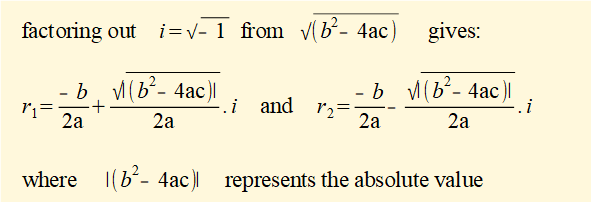This series of tutorials on the subject of mechanical vibrations hinges on solutions to a particular type of differential equation defined as ordinary, second order, linear, homogeneous or non-homogeneous. The purpose of this tutorial is to explain some general methods for finding these solutions. A reasonable knowledge of college level algebra and basic calculus is assumed.
Definitions of this type of differential equation are as follows.- ordinary means that all derivatives of the one dependent variable in the equation are with respect to the same independent variable (i.e. there are no partial derivatives)
- second order means that the highest derivative in the equation is of the second order
- linear means that the exponent of each term containing the dependent variable in the equation is one
- homogeneous equations of this type equal zero; non-homgeneous equations do not
Additionally, all terms in the equations considered have constant coefficients.
In this tutorial y denotes dependent variables and x independent variables. Thus a solution means finding a function y = f(x) that satisfies the equation in question. In subsequent tutorials the dependent and independent variables are typically x (displacement) and t (time) respectively.
Solutions to homogeneous equations
We first consider a solution to the homogeneous equation which has the general form:

In many cases the starting point for a solution to a differential equation is to find a function that could be the basis for a solution.

Replacing y and its derivatives in (1) above with expressions in erx gives:

Because erx cannot equal zero this equation reduces to: ar2 + br + c = 0 known as the characteristic equation of the original differential equation.



It can be shown that any linear combination of these solutions is also a solution. Hence the general solution can be expressed as:

A particular solution of the original equation requires values for constants C1 and C2. These are found by setting initial conditions for y and dy/dx when x = 0 and substituting these values in equations (2a) and (2b) giving two equations with two unknowns (C1 and C2).
We now examine solutions r1 and r2 of the characteristic equation taking account of the value of the term (b2 - 4ac) in the quadratic formula.
1. (b2 - 4ac) > 0
If (b2 - 4ac) > 0 then r1 and r2 are real numbers and the general solution can be obtained directly from equation (2) above.
2. (b2 - 4ac) < 0
If (b2 - 4ac) < 0 then r1 and r2 can be expressed as a pair of complex conjugate numbers as follows:



We now expand equation (3) to give:





Now replace the constant terms in the above equation with "new" constants C1 and C2 respectively.

Equation(4) has no terms in i making it much easier to apply as a general solution than equation (3) above
Further simplification expresses the general solution of equation (4) as a single cosine function in the following way.
From the identity A.cos(θ) + B.sin(θ) = R.cos(θ - φ)
where R = √(A2 + B2) and φ = tan-1 (B /A)
it follows that:
y = R.eαx cos(βx - φ) --------- (5)
where R = √(C12 + C22) and φ = tan-1 (C2 / C1)
3. (b2 - 4ac) = 0
If (b2 - 4ac) = 0 then the characteristic equation has repeated roots, r and the general solution of equation 2(a):

becomes y = C.erx ------ (2c) with constant C.
This is not a complete general solution because two initial conditions, and thus two constants, are required. However, it can be shown that equation (5) below, known as reduction of order, provides a template for solutions where there are repeated roots:
y = C1erx + C2x.erx -------- (5)
In subsequent tutorials we use the general solutions above to solve the homogeneous equations of motion for free vibrating systems.
Solutions to non-homogeneous equations

The general solution to this form of equation is:
+
This is understood better by working through an example for the following non-homogeneous equation (6):

We use a cosine function f(x) = 2cos(3x) in our example because a function of this type arises in non-homogeneous equations of motion for forced vibrating systems.
Step 1 - find the general solution to the complementary homogeneous equation


Step 2 - find the particular solution to the non-homogeneous equation
A starting point is to find two functions whose first and second derivatives replicate each other. Sine and cosine functions give a possible particular solution to equation (6) as follows:

What follows is called the method of undetermined coefficients where we find coefficients A and B by substituting yp, yp/ and yp// in equation (6).
yp/ = - 3.A.sin(3x) + 3.B.cos(3x)
yp// = -9.A.cos(3x) - 9.B.sin(3x)
Substituting in equation (6) gives:
-9.A.cos(3x) - 9.B.sin(3x) -6.A.sin(3x) +6.B.cos(3x) -3. A.cos(3x) -3.B.sin(3x) = 2.cos(3x)
giving (- 12A + 6.B).cos(3x) + ( - 6.A - 12B).sin(3x) = 2.cos(3x)
equating coefficients for cos(3x) and sin(3x) on both sides of the equation gives:
(- 12A + 6.B) = 2 and (- 6.A - 12B) = 0


Step 3 - combine solutions
The general solution yg to the non-homogeneous equation (6) is a combination of the solution yc to the complementary homogeneous equation and the particular solution yp to equation (6) which gives:

Next: Free vibrations
I welcome feedback at: